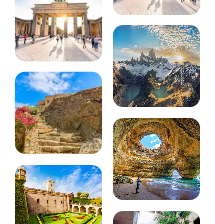The 9 most beautiful districts to visit in Marseille
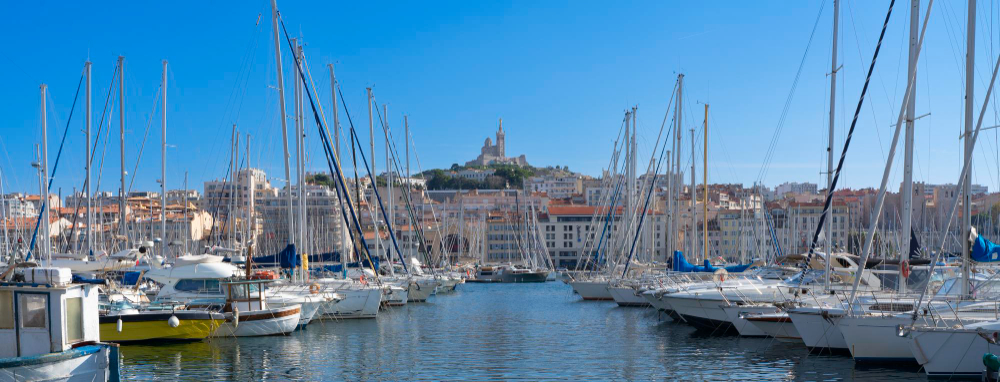
Marseille, the city of a thousand faces, seduces travellers with the exceptional diversity of its districts. Each has its own unique identity, combining a thousand years of history, the Mediterranean art of living and creative modernity. From the picturesque alleyways of the Panier to the shopping avenues of the Canebière and the breathtaking panoramas of Notre-Dame-de-la-Garde, the city offers a kaleidoscope of atmospheres to explore. This urban mosaic reflects the soul of Marseille, an authentic blend of Provençal traditions and cosmopolitan influences forged by centuries of maritime trade.
200 audioguided tours for cities all around the world
Download1. The Panier district
Considered to be the cradle of Marseille, the Panier district is the oldest part of the city. Perched on a mound overlooking the Old Port, this labyrinth of narrow streets and cobbled staircases tells the story of 2,600 years of Marseille’s history. The colourful facades, adorned with Provencal shutters and contemporary street art, create a unique atmosphere where past and present mingle.
Art and history lovers will discover the Vieille Charité, a former 17th-century hospice that has been transformed into a cultural centre housing several museums. The Maison Diamantée, a Renaissance building with diamond-cut stonework, bears witness to the district’s rich architectural past. The Accoules church, a vestige of medieval times, completes this exceptional heritage.
Today, the Panier is alive with artists’ studios, art galleries and local craft shops. The café terraces offer welcome breaks from the hustle and bustle of the district, while the small shady squares invite you to take a stroll. Let the Visiter Marseille itinerary be your guide as you explore this emblematic district, revealing all its secrets.
See also the Marseille guide :
- Top 15 things to do in and around Marseille
- Discover the most beautiful creeks in Marseille and Cassis
- Discover and visit Notre-Dame-de-la-Garde in Marseille
- Top 11 culinary specialities in Marseille
- Discover Marseille’s most beautiful beaches
- What are the most beautiful villages to discover around Marseille?
- Top 5 events in Marseille
- 20 not-to-be-missed excursions around Marseille
2. The Old Port district
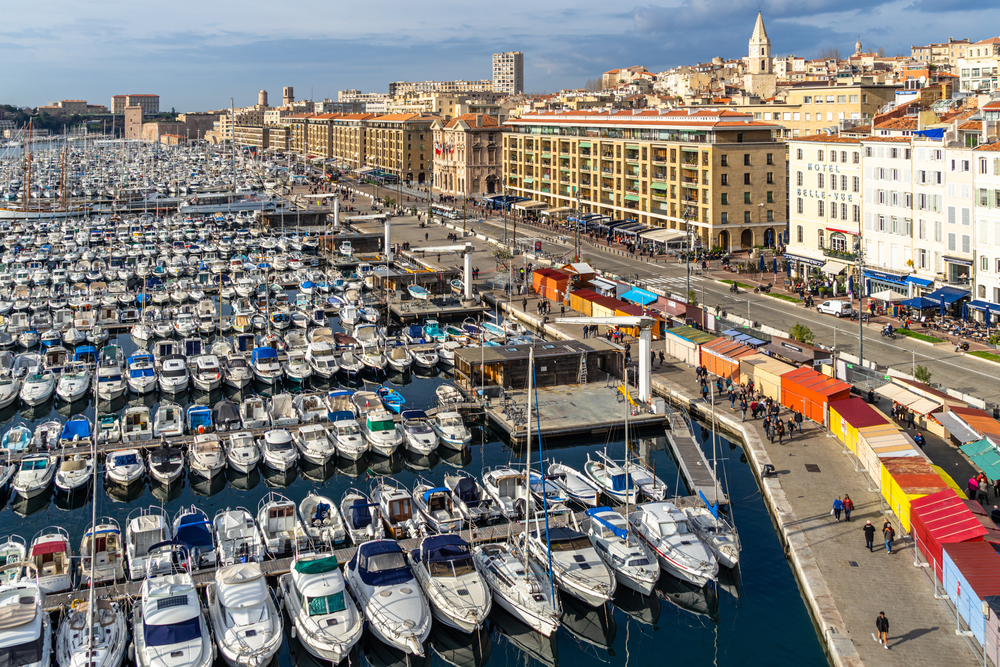
The beating heart of Marseille since antiquity, the Vieux-Port remains the very soul of the city. This natural harbour, where the first Greek settlers docked more than 2,600 years ago, has retained its maritime vocation while flourishing as the nerve centre of Marseilles life. The renovated quays provide an exceptional setting for a stroll, while the morning fish market continues a centuries-old tradition.
The architecture of the area bears witness to Marseille’s urban development. The Saint-Nicolas and Saint-Jean forts, built in the 17th century by Louis XIV, guard the entrance to the port and today house cultural facilities. The MuCEM (Musée des Civilisations de l’Europe et de la Méditerranée), linked to Fort Saint-Jean by a spectacular footbridge, symbolises the modernity of Marseille’s architecture.
The restaurants and brasseries lining the quays offer authentic Mediterranean cuisine, with uninterrupted views over the bustling port. Numerous shipping companies organise excursions to the Frioul islands or the calanques, allowing you to discover Marseille from the sea. Norman Foster’s Ombrière, a contemporary structure protecting the pedestrian area, creates a play of light and shadow that enhances the atmosphere of the place.
3. The Notre-Dame-du-Mont district
Located in the heights of the 6th arrondissement, the Notre-Dame-du-Mont district embodies the bohemian and artistic spirit of Marseille. Built around the famous Cours Julien, this alternative area attracts a cosmopolitan population of artists, students and creative types. Legally tagged walls make this area a veritable open-air street art museum, showcasing the talents of Marseille’s contemporary art scene.
The Cours Julien is the epicentre of this cultural effervescence. Its lively terraces, vintage boutiques and art galleries create an atmosphere that is unique in Europe. The Wednesday morning flea market attracts bargain hunters, while the many bars and restaurants offer world cuisine that reflects Marseille’s diversity. The Notre-Dame-du-Mont church, which gives its name to the district, offers a panoramic view of the city.
The area’s nightlife extends far beyond Marseille’s borders. Jazz clubs, alternative music scenes and theme bars liven up the evenings, creating a festive atmosphere that lasts until the early hours of the morning. This constant cultural effervescence makes the Notre-Dame-du-Mont district a must for anyone wanting to capture the modern, creative soul of Marseille.
4. The Canebière district
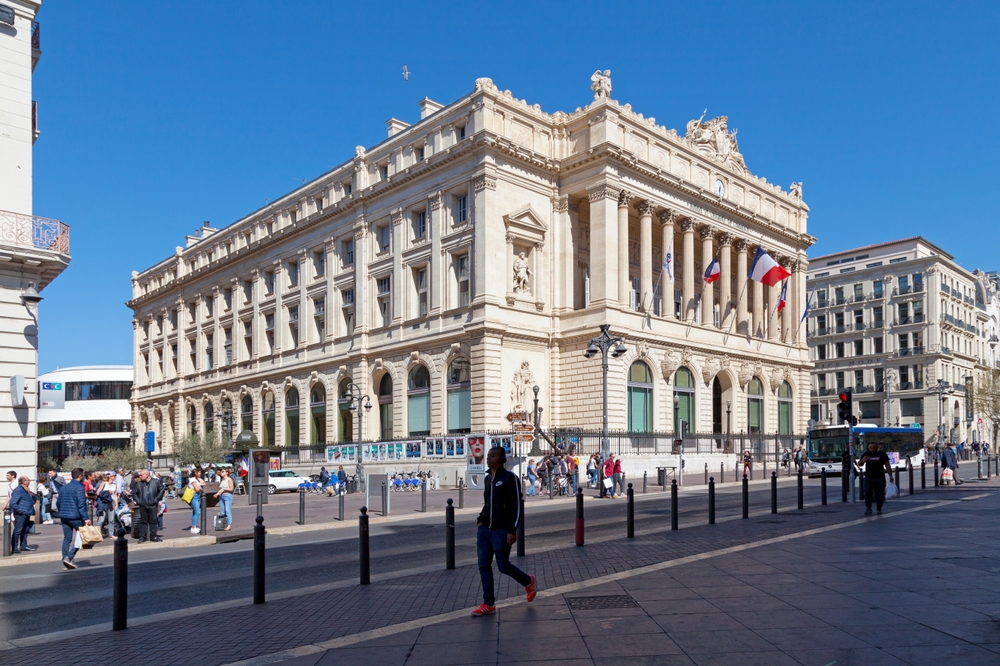
A symbol of Marseille’s soul, the Canebière runs through the historic heart of the city, linking the Old Port to the Eglise des Réformés. This legendary thoroughfare, nicknamed the “Champs-Élysées of Marseille”, is the hub of the city’s commercial and cultural life. Its wide pavements welcome a cosmopolitan crowd of tourists, shopkeepers and locals, creating a typically Mediterranean atmosphere.
The eclectic architecture of the Canebière tells the story of Marseille. The Opéra de Marseille, rebuilt in the 19th century after a fire, boasts a neo-classical façade and an internationally renowned opera season. Haussmann-style buildings stand side by side with Art Deco edifices that bear witness to the different periods of prosperity in Marseille. The former department stores, now converted, still have their beautiful period shop windows.
The district vibrates to the rhythm of its markets, particularly the Noailles market, which offers exotic produce and Mediterranean specialities in an oriental souk atmosphere. The historic cafés, testimony to Marseille’s social life, perpetuate the Provencal art of living. This emblematic thoroughfare is a must-see if you want to understand Marseille’s identity and soak up its legendary authenticity.
5. The Endoume district
Nestling in Marseille’s 7th arrondissement, the Endoume district has a reputation for preserving its authenticity and offering exceptional views over the Mediterranean. This residential area, set in the hills overlooking the sea, offers a privileged living environment where Provencal traditions and the Mediterranean art of living come together. The narrow, stepped streets, lined with villas with flower gardens, create a village-in-the-town atmosphere.
The Vallon des Auffes is the jewel in the crown of this district. This picturesque little fishing port, accessible via the Corniche Président Kennedy, seems to be suspended between sea and sky. Its colourful cottages, traditional boats and fish restaurants create a picture-postcard backdrop that is much appreciated by photographers from all over the world. The “pointus”, Marseilles’ traditional fishing boats, perpetuate an ancestral activity in the heart of the modern city.
The church of Saint-Vincent-de-Paul, a neo-Byzantine building dating from the 19th century, dominates the district with its imposing silhouette. Its mosaics and interior decoration bear witness to the religious art of Marseille. The green spaces, particularly the Parc Valmer and its terraced gardens, offer a haven of tranquillity with panoramic views over the Frioul islands. This privileged location makes Endoume one of Marseille’s most sought-after districts.
Download the audio tour to discover Marseille on foot and on your own
Explore the hidden treasures of Marseille with our interactive audio itinerary specially designed for self-guided visitors. This discovery tour takes you through Marseille’s iconic districts, revealing their fascinating histories and best-kept secrets. Download the Marseille audio tour now and let our informative commentary guide you to an unforgettable visit.
6. La Joliette district
A symbol of Marseille’s renewal, the La Joliette district embodies the city’s contemporary metamorphosis. This historic port area has been transformed into a modern business district while preserving its industrial heritage. Renovated warehouses stand alongside futuristic office towers, creating a striking contrast that perfectly illustrates Marseille’s ability to reconcile tradition and modernity.
The MuCEM, an architectural gem designed by Rudy Ricciotti, is the major attraction in the area. This museum, dedicated to Mediterranean civilisations, presents temporary exhibitions of international renown in a spectacular contemporary setting. Its ultra-high-performance fibre-reinforced concrete mesh creates a play of light and shadow that changes according to the time of day and the season, offering a permanent architectural spectacle.
Les Docks de Marseille, a shopping centre housed in former 19th-century warehouses, is a fine example of the successful conversion of industrial heritage. Its red brick vaults house shops, restaurants and cultural spaces, creating a lively place to live on the Mediterranean coast. The seafront promenade offers exceptional views of the open sea and the islands, while the restaurant terraces allow you to savour Marseille’s gastronomy overlooking the sea.
7. The Roucas-Blanc district
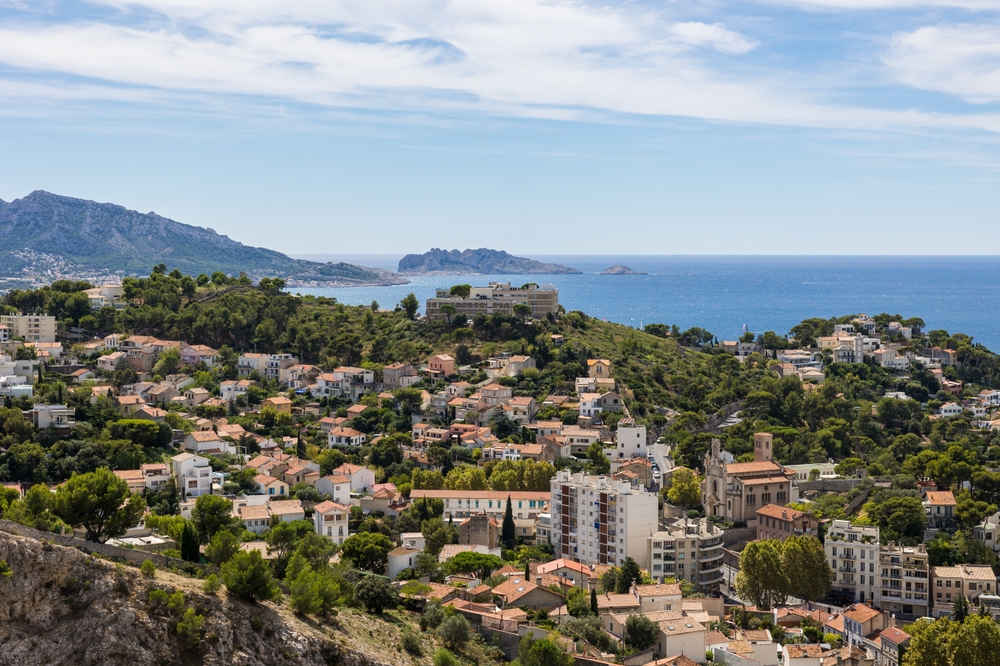
Perched on the heights of the 7th arrondissement, the Roucas-Blanc district offers one of the most privileged living environments in Marseille. This residential hill, named after the white colour of its limestone rocks, is home to sumptuous Belle Époque villas nestling in lush vegetation. The winding streets, lined with palm trees and umbrella pines, create a French Riviera atmosphere in the heart of the city.
The Basilica of Notre-Dame-de-la-Garde, the “Good Mother” of the people of Marseille, crowns the hill majestically. Built in the 19th century in the neo-Byzantine style, it offers a 360-degree panoramic view of Marseille, its districts, its creeks and the Mediterranean. Its remarkable architecture, gilded mosaics and statue of the Virgin Mary gilded with fine gold make it one of the most visited monuments in France. The ascent on foot or by tourist train is an essential part of any visit to Marseille.
The Parc Valmer, set in the gardens of a former villa, offers a haven of greenery with a panoramic view over the Bay of Marseille. Its terraced gardens, rose garden and Mediterranean species create a haven of tranquillity much appreciated by walkers. The Corniche Président Kennedy, which runs around the hill, is one of the most beautiful urban promenades in Europe, linking the Old Port to the Prado beaches in a dream setting.
8. The Noailles district
A veritable cultural kaleidoscope, the Noailles district embodies Marseille’s diversity in all its richness. Situated between the Canebière and the Cours Julien, this popular area is home to a mosaic of communities that make up the cosmopolitan richness of Marseille. Its lively streets, exotic shops and restaurants from all over the world create a Mediterranean souk atmosphere that is unique in France.
The Noailles market is the beating heart of this district. Every morning, the colourful stalls sell oriental spices, tropical fruit, Mediterranean vegetables and culinary specialities from the Maghreb, sub-Saharan Africa and Asia. This profusion of flavours and scents transforms a simple daily errand into a sensory voyage around the Mediterranean basin. The shopkeepers, many of whom have been in business for several generations, perpetuate a typically Marseillaise art of convivial commerce.
The district’s architecture bears witness to Marseille’s working-class history. Nineteenth-century buildings, with facades that are sometimes decrepit but still inhabited, stand alongside renovated buildings that are attracting a new population of artists and designers. This gradual gentrification is transforming the district’s identity while preserving its working-class authenticity. Cultural and community initiatives are flourishing, creating a dynamic urban renewal that respects local traditions.
9. The L’Estaque district
Anchored in Marseille’s industrial history, the L’Estaque district retains its fishing village soul despite the progressive urbanisation of the area. Located in the 16th arrondissement, in the north of Marseille, this picturesque area has inspired some of the greatest Impressionist and Post-Impressionist painters. Paul Cézanne, Auguste Renoir and Georges Braque drew their inspiration here, seduced by the exceptional quality of the Mediterranean light and the beauty of the seascapes.
The small port of L’Estaque continues the traditional fishing tradition of Marseille. Its colourful pointus boats, moored along the quayside, create an authentic backdrop much appreciated by contemporary artists. The port’s restaurants offer generous seafood dishes, with bouillabaisse and Provencal specialities served facing the Mediterranean. Traditional shipyards maintain ancestral know-how in the construction and repair of fishing boats.
The Usine électrique, a former power station converted into a cultural space, symbolises the successful reconversion of industrial heritage. Its temporary exhibitions and diverse artistic programme attract a discerning public from beyond Marseille’s borders. The Alhambra cinema, one of the district’s cultural institutions, screens arthouse films in an intimate setting. These cultural facilities are helping to revitalise L’Estaque while preserving its popular, maritime identity.
In conclusion, these nine emblematic districts reveal the exceptional richness of Marseille, a multi-faceted city where each sector tells a part of Mediterranean history. From the historic Panier to the architectural innovations of La Joliette, via the preserved authenticity of L’Estaque, the city of Marseille offers a journey through centuries and cultures. This urban diversity makes Marseille an unmissable tourist destination, where every stroll reveals new heritage and cultural treasures. To make the most of your discovery of these fascinating districts, don’t hesitate to use our audio tour of Marseille, which will accompany you on this exceptional urban exploration.
FAQ
Which is Marseille’s most beautiful district?
The Panier district is often considered to be the most beautiful part of Marseille, thanks to its historic authenticity and picturesque charm. Its cobbled streets, colourful facades and exceptional architectural heritage make it a must-see on any visit to Marseille.
Which areas to avoid in Marseille?
The northern districts of Marseille require more caution, particularly certain areas of the 13th, 14th and 15th arrondissements. However, the tourist areas of the city centre, such as the Old Port, the Panier and the Canebière, are perfectly safe for visitors.
How do you get around Marseille’s different districts?
Marseille has an excellent public transport network, with metro, tram and bus services. The metro links the main districts efficiently, while walking remains the best way to discover the authentic atmosphere of each area, particularly in the historic centre.
How long does it take to visit the districts of Marseille?
A complete tour of Marseille’s main districts will take a minimum of 2 to 3 days. One day may be enough to discover the Panier and the Old Port, while a second day will allow you to explore Notre-Dame-de-la-Garde, Endoume and the Corniche. The third day can be devoted to more outlying districts such as L’Estaque and La Joliette.
200 audioguided tours for cities all around the world
Download